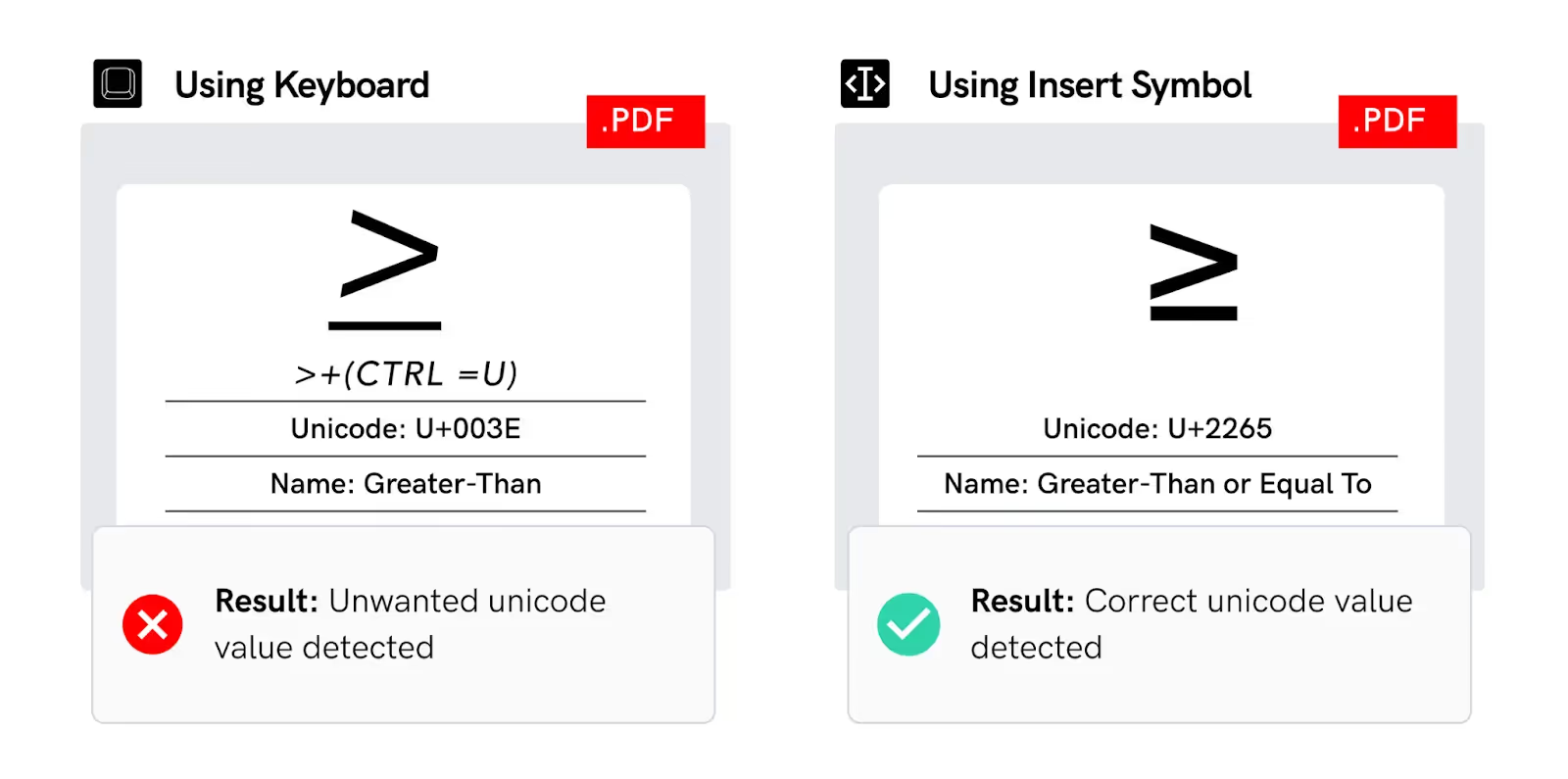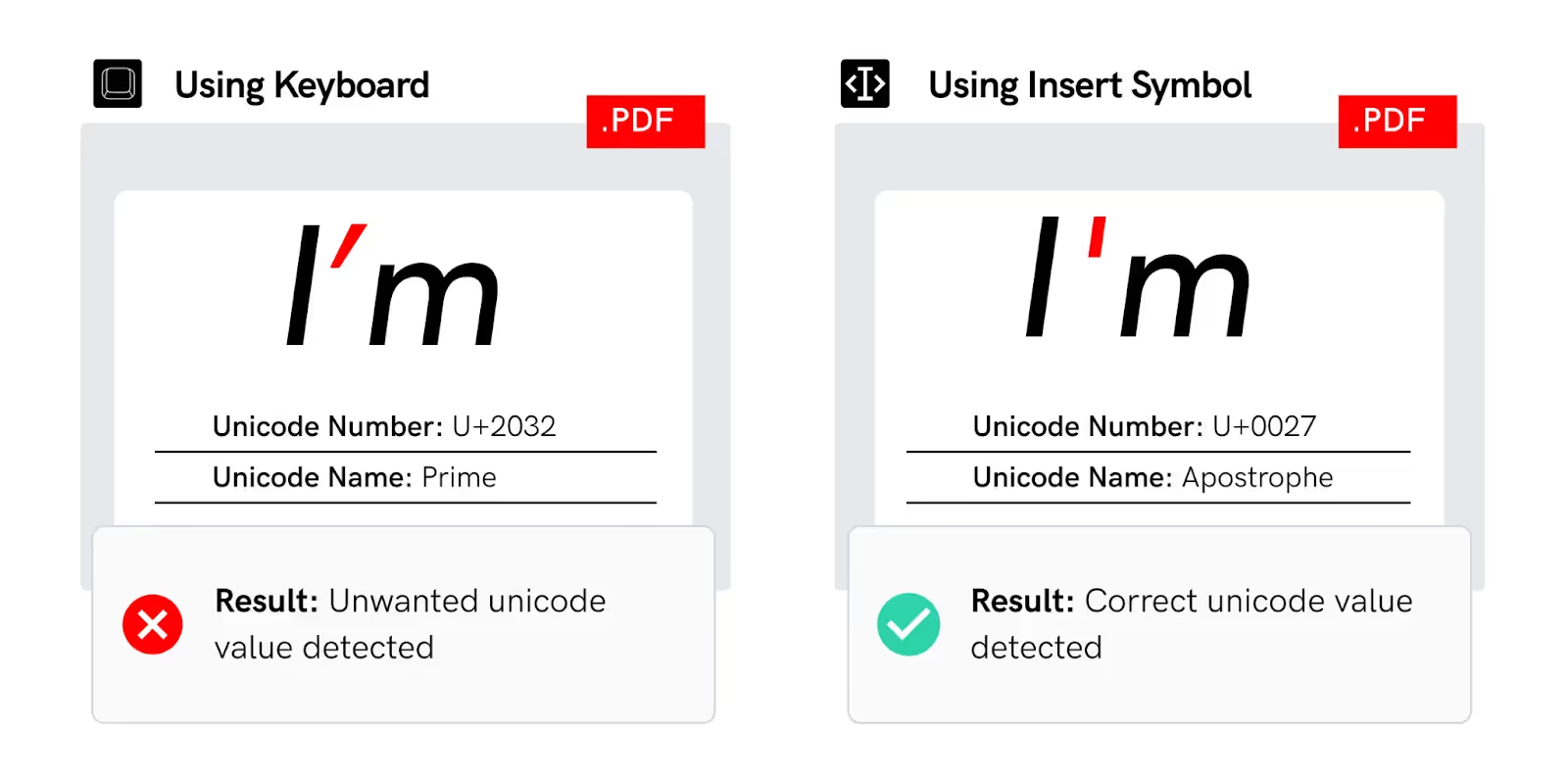Symbols
Symbols and special characters are useful in many text applications. These symbols and characters are typically those not found in the English language. They are very useful for writing in different languages, creating math equations, using different currency symbols and more. However, these symbols and special characters may not be accessible if not created properly.
For example, an alpha (α) in a formula could be coded in various ways:
• The Unicode character U+03B1.
• A simple "a" in a Greek font (α).
• A vector graphic unassociated with the corresponding character belonging to ASCII or Unicode.
See Appendix 09: Unicode value table of the commonly used special characters.
This could lead to different results when hypothetically searching for "alpha" in a given document. In the first case, it would be found easily. In the second case, a search would stop at every single "a" instead. In the third case, the search wouldn't produce a single match, as the character in question would be a graphic.
In this section, GlobalVision describes how to create symbols and special characters to easily access them.
Creating symbols and special characters in Microsoft Word
Risk
If symbols and special characters are not created properly, the PDF file integrity may become compromised.
Issue
The incorrect Unicode representation of a symbol may be used if symbols are not inserted using the symbol dialog box.
Example

Solution
Do:
- Use the symbol function to create symbols and special characters.
- Standardize on the method used to create symbols and special characters.
- In Microsoft Word, go to the "Insert" tab, click on "Symbol," and choose "More Symbols."
Don’t:
- Use the keyboard to combine characters to simulate symbols.
- Copy and paste symbols from PDF documents.
- Use graphics and/or images as symbols.
Tips
The following steps describe how to view information about Unicode on
Character Map (Windows) or Character Viewer (macOS).
To explore and view information about Unicode characters:
On Windows
- You can find "Character Map" by searching in the Start menu.
On macOS
- You can access "Character Viewer" from the menu bar or by pressing "Control + Command + Space."
Creating symbols and special characters in design programs
Risk
If symbols and special characters are not created properly, the PDF file integrity may become compromised.
Issue
Graphic artists sometimes use the wrong symbols for apostrophes, quotation
marks, and unit values. As a result, the artwork PDF may contain incorrect
Unicode values.
Example

Solution
Do:
- Use the symbol function to create symbols and special characters.
- Standardize on the method used to create symbols and special characters.
- Use the Glyphs panel to access special characters and symbols.
Don’t:
- Copy and paste symbols from PDF documents.
- Use graphics/images as symbols.
Tips
The following steps detail how to identify Unicode characters in Adobe Illustrator and InDesign:
- Select the desired character.
- Go to the Type menu and select Glyphs to display the corresponding Unicode value.
Standardizing symbols and characters
Risk
If symbols and characters are not standardized, inconsistencies may appear in different documents.
Issue
Special characters such as bullets, trademarks, quotation marks, and apostrophes have many variations. Each variation is represented by a different “code” (see Section 4 Unicode Standard).
Example

Solution
Do:
- Standardize on a list of symbols and special characters.
- Use the symbol function or symbol palette to create symbols and special
characters.
- Standardize on the method used to create symbols and special characters.
Don’t:
- Use the keyboard to create symbols in Microsoft Word.
- Copy and paste symbols from PDF documents.
- Use graphics/images as symbols.
Tips
The followings tools may be used to help standardize on symbols and characters:
- Symbol Palette in Microsoft Word.
- Glyph Palette in Adobe InDesign and Illustrator.
See Appendix 09: Unicode value table of the commonly used special characters.
Managing hyphens in artwork files
Risk
If you do not manage hyphens in artwork files, inconsistencies may appear in different documents and artwork files.
Issue
Hyphens may be created in multiple ways. Each variation is represented by a
different “code” (see Section 4 Unicode Standard).
Example

Solution
Do:
- Use the same hyphenation set-up for both the Master and Sample files.
- Use soft hyphens in the same word location, in both the Master and Sample
files.
- Use the same auto-hyphenation mode (ON or OFF) in both the Master and
Sample files.
Don’t:
- Turn on the Hyphenation feature in just the Master or just the Sample files.
- Use soft hyphens in only the Master or only the Sample files.
- Use a minus sign to hyphenate.
Tips
The following steps detail how to create a soft hyphen.
Adobe InDesign:
- Go to Type and select Insert Special Character.
- Select Discretionary Hyphen from Hyphens and Dashes.
Microsoft Word:
- Click where you would like to insert a soft hyphen.
- In the Symbol dialog box, select the Special Characters tab and insert Optional Break (sometimes labeled as "Soft Hyphen").
Managing ligatures in artwork files
Risk
If you do not manage ligatures in artwork files properly, unwanted ligatures may be detected on the final approved materials by the proofreading software.
Issue
The proofreading software may detect invalid ligatures.
Example

Solution
Do:
- Turn ligatures OFF for standard fonts.
- Use extended OpenType fonts if ligatures are required.
- Use the same setting in both the Master and Sample file (Ligatures ON or OFF).
- OpenType fonts often support a wide range of ligatures. Use these fonts for better control over ligature options.
Don’t:
- Use ligatures in the document if not required.
- Set ligatures to ON for standard fonts.
Tips
The following steps describe how to turn Ligatures ON or OFF.
Adobe Illustrator:
- Go to Window and select Type.
- Select OpenType and turn Ligatures ON or OFF.
Adobe InDesign:
- Turn Ligatures OFF or ON in the drop-down menu of the Character panel.


